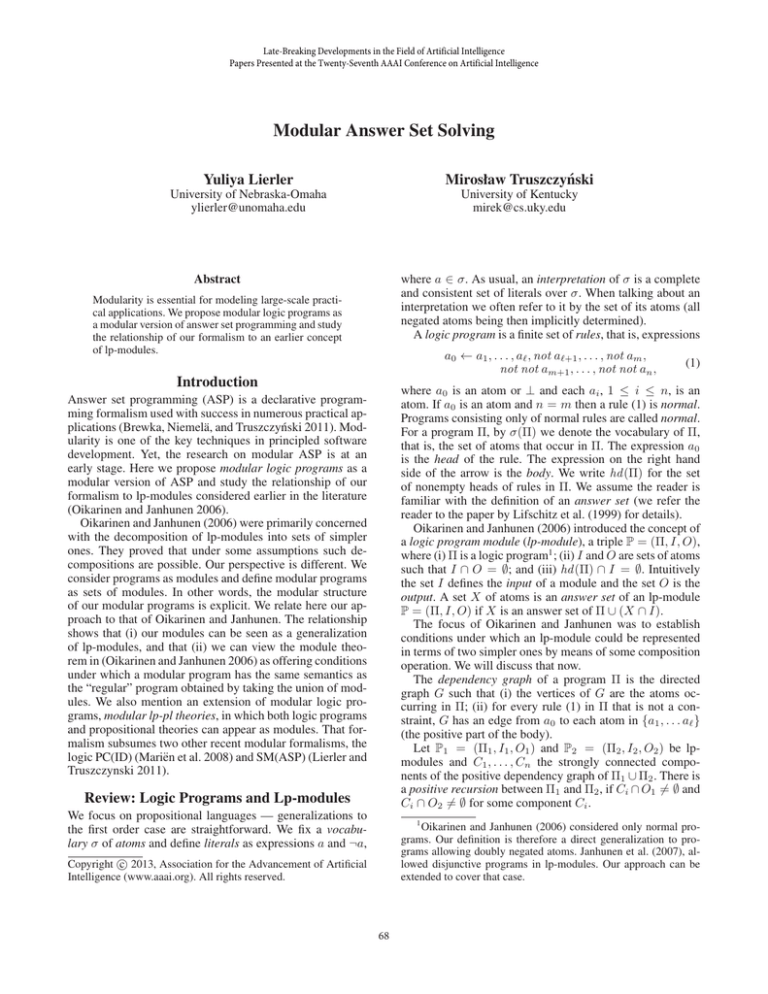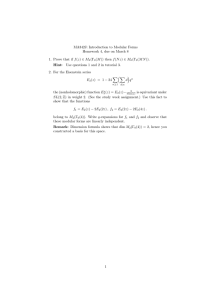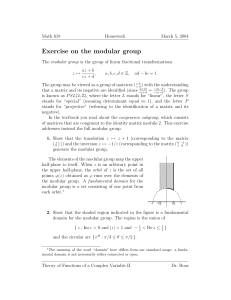Modular Answer Set Solving Yuliya Lierler Mirosław Truszczy ´nski
advertisement

Late-Breaking Developments in the Field of Artificial Intelligence
Papers Presented at the Twenty-Seventh AAAI Conference on Artificial Intelligence
Modular Answer Set Solving
Yuliya Lierler
Mirosław Truszczyński
University of Nebraska-Omaha
ylierler@unomaha.edu
University of Kentucky
mirek@cs.uky.edu
where a ∈ σ. As usual, an interpretation of σ is a complete
and consistent set of literals over σ. When talking about an
interpretation we often refer to it by the set of its atoms (all
negated atoms being then implicitly determined).
A logic program is a finite set of rules, that is, expressions
Abstract
Modularity is essential for modeling large-scale practical applications. We propose modular logic programs as
a modular version of answer set programming and study
the relationship of our formalism to an earlier concept
of lp-modules.
a0 ← a1 , . . . , a` , not a`+1 , . . . , not am ,
not not am+1 , . . . , not not an ,
Introduction
(1)
where a0 is an atom or ⊥ and each ai , 1 ≤ i ≤ n, is an
atom. If a0 is an atom and n = m then a rule (1) is normal.
Programs consisting only of normal rules are called normal.
For a program Π, by σ(Π) we denote the vocabulary of Π,
that is, the set of atoms that occur in Π. The expression a0
is the head of the rule. The expression on the right hand
side of the arrow is the body. We write hd (Π) for the set
of nonempty heads of rules in Π. We assume the reader is
familiar with the definition of an answer set (we refer the
reader to the paper by Lifschitz et al. (1999) for details).
Oikarinen and Janhunen (2006) introduced the concept of
a logic program module (lp-module), a triple P = (Π, I, O),
where (i) Π is a logic program1 ; (ii) I and O are sets of atoms
such that I ∩ O = ∅; and (iii) hd (Π) ∩ I = ∅. Intuitively
the set I defines the input of a module and the set O is the
output. A set X of atoms is an answer set of an lp-module
P = (Π, I, O) if X is an answer set of Π ∪ (X ∩ I).
The focus of Oikarinen and Janhunen was to establish
conditions under which an lp-module could be represented
in terms of two simpler ones by means of some composition
operation. We will discuss that now.
The dependency graph of a program Π is the directed
graph G such that (i) the vertices of G are the atoms occurring in Π; (ii) for every rule (1) in Π that is not a constraint, G has an edge from a0 to each atom in {a1 , . . . a` }
(the positive part of the body).
Let P1 = (Π1 , I1 , O1 ) and P2 = (Π2 , I2 , O2 ) be lpmodules and C1 , . . . , Cn the strongly connected components of the positive dependency graph of Π1 ∪ Π2 . There is
a positive recursion between Π1 and Π2 , if Ci ∩ O1 =
6 ∅ and
Ci ∩ O2 6= ∅ for some component Ci .
Answer set programming (ASP) is a declarative programming formalism used with success in numerous practical applications (Brewka, Niemelä, and Truszczyński 2011). Modularity is one of the key techniques in principled software
development. Yet, the research on modular ASP is at an
early stage. Here we propose modular logic programs as a
modular version of ASP and study the relationship of our
formalism to lp-modules considered earlier in the literature
(Oikarinen and Janhunen 2006).
Oikarinen and Janhunen (2006) were primarily concerned
with the decomposition of lp-modules into sets of simpler
ones. They proved that under some assumptions such decompositions are possible. Our perspective is different. We
consider programs as modules and define modular programs
as sets of modules. In other words, the modular structure
of our modular programs is explicit. We relate here our approach to that of Oikarinen and Janhunen. The relationship
shows that (i) our modules can be seen as a generalization
of lp-modules, and that (ii) we can view the module theorem in (Oikarinen and Janhunen 2006) as offering conditions
under which a modular program has the same semantics as
the “regular” program obtained by taking the union of modules. We also mention an extension of modular logic programs, modular lp-pl theories, in which both logic programs
and propositional theories can appear as modules. That formalism subsumes two other recent modular formalisms, the
logic PC(ID) (Mariën et al. 2008) and SM(ASP) (Lierler and
Truszczynski 2011).
Review: Logic Programs and Lp-modules
We focus on propositional languages — generalizations to
the first order case are straightforward. We fix a vocabulary σ of atoms and define literals as expressions a and ¬a,
1
Oikarinen and Janhunen (2006) considered only normal programs. Our definition is therefore a direct generalization to programs allowing doubly negated atoms. Janhunen et al. (2007), allowed disjunctive programs in lp-modules. Our approach can be
extended to cover that case.
c 2013, Association for the Advancement of Artificial
Copyright Intelligence (www.aaai.org). All rights reserved.
68
The join of modules P1 = (Π1 , I1 , O1 ) and P2 =
(Π2 , I2 , O2 ), denoted by P1 t P2 , is defined if O1 ∩ O2 = ∅;
there is no positive recursion between Π1 and Π2 ; and
atoms is an input answer set of the program. Thus, atoms
that do not appear as heads are no longer subject to CWA but
are “open.” The way we use answer sets here to define the
semantics of input modular logic programs is essentially the
same as that used in (Denecker et al. 2012) and (Denecker
and Ternovska 2008) to handle D-modules and definitions
respectively.
To relate the semantics of input answer sets and answer
sets of lp-modules, for a program Π we define an lp-module
induced by Π to be the lp-module
(σ(Π1 )\(I1 ∪O1 ))∩σ(Π2 ) = (σ(Π2 )\(I2 ∪O2 ))∩σ(Π1 ) = ∅.
If the join is defined, it is given by
P1 t P2 = (Π1 ∪ Π2 , (I1 \ O2) ∪ (I2 \ O1 ), O1 ∪ O2).
Theorem 1 (Module theorem) For normal modules P1 , P2
and a set X of atoms over σ(P1 t P2 ), if P1 t P2 is defined,
then X is an answer set of P1 t P2 iff X1 = X ∩ σ(P1 ) and
X2 = X ∩ σ(P2 ) are answer sets of P1 and P2 respectively.
P(Π) = (Π, σ(Π) \ hd (Π), hd (Π)).
Theorem 2 A set X of atoms is an input answer set of a
program Π if and only if X ∩ σ(Π) is an answer set of P(Π).
Thus, input answer sets of programs can be specified in
terms of answer sets of lp-modules. There is a similar connection in the opposite direction.
Theorem 3 A set X of atoms is an answer set of an lpmodule (Π, I, O) if and only if X is an input answer set
of Π and X ⊆ hd (Π) ∪ I.
Theorems 2 and 3 show that programs with the semantics of input answer sets are closely related to lpmodules (Oikarinen and Janhunen 2006).
The following result establishes the relation between pairs
of “joinable” lp-modules and modular logic programs.
Theorem 4 For programs Π1 and Π2 such that P(Π1 ) t
P(Π2 ) is defined, and a set X of atoms over σ(Π1 ∪ Π2 ),
X is an answer set of P(Π1 ) t P(Π2 ) if and only if X is an
answer set of the modular logic program {Π1 , Π2 }.
The semantics of input answer sets makes it possible
to combine logic programs and propositional theories in a
mixed modular theory.
Definition 4 A modular lp-pl theory is a set of logic programs and propositional theories. Given an lp-pl theory T ,
a set X of atoms is an answer set of T if X is an input answer set of every program Π ∈ T and a (classical) model of
every propositional theory T ∈ T .
In modular lp-pl theories one can replace all modules that
are propositional theories by a single module, their union.
Such simplifications are, in general not possible with modules that are programs. However, in some cases a counterpart to the module theorem for lp-modules can be proved
so that simplification is possible. Lp-pl theories are closely
related to the logic PC(ID) (Mariën et al. 2008). In the
case when they consist of a single program and a single
propositional theory they were considered by Lierler and
Truszczynski (2011).
Note that Oikarinen and Janhunen do not consider modular systems as such, i.e., collections of lp-modules and their
overall semantics. In the following section we address this
issue by introducing modular logic programs.
Modular Logic Programs
We start by defining input answer sets, the key semantic object for facilitating the communication between modules.
Definition 1 (Lierler and Truszczynski 2011) A set X of
atoms is an input answer set of a logic program Π if X is an
answer set of the program Π ∪ (X \ hd (Π)).
As before, we regard answer sets and input answer sets,
which are sets of atoms, as interpretations.
Definition 2 A set of logic programs is a modular logic program or, simply, a modular program.
Definition 3 Given a modular program P, a set X of atoms
is an answer set of P if X is an input answer set of every
program Π in P.
For example, let Π1 be a program {a ← b, c ← not b}
and Π2 be {b ← not not b. ← c}. Set {a, b} is the only
answer set over the signature {a, b, c} of a modular program
{Π1 , Π2 }.
Modular logic programs are expressions to model situations where several independently developed “knowledge
modules” need to be combined. Syntactically, the matter is
trivial. The key question lies in the semantics. How to interpret the module “composition” operation? We treat it in the
most natural fashion as the conjunction. That is, an interpretation is a model of the combined system if and only if it is a
model of each individual module. However, the semantics of
answer sets, if taken literally, is inappropriate. It would lead
to trivial results with the composition of modules typically
having no answer sets. In particular, if modules are based
on disjoint signatures, the only possibility for the combined
system to have an answer set would be when an empty set
were the answer set of every module.
Input answer sets address this problem. They can be
viewed as a more general version of answer sets. Under the
restriction to the head atoms, they coincide with answer sets.
If the signature contains atoms other than those appearing in
the heads of rules, those atoms are treated as “input” atoms.
They can be interpreted arbitrarily, their values “inform” the
program. If that “informed” program has an answer set, that
answer set extended by the “input” interpretation of input
Discussions
Järvisalo et al. (2009), and Tasharrofi and Ternovska (2011)
also studied the generalizations of lp-modules. In that work
the main focus was to abstract lp-modules formalism away
from any particular syntax or semantics. In contrast, we are
interested in building simple modular systems on top of specific formalisms — ASP, or ASP and propositional logic.
Extensions to cover other constraint formalisms are left for
the future work.
69
References
Brewka, G.; Niemelä, I.; and Truszczyński, M. 2011. Answer set programming at a glance. Communications of the
ACM 54(12):92–103.
Denecker, M., and Ternovska, E. 2008. A logic of nonmonotone inductive definitions. ACM Trans. Comput. Log.
9(2).
Denecker, M.; Lierler, Y.; Truszczynski, M.; and Vennekens,
J. 2012. A tarskian informal semantics for answer set programming. In Technical Communications of the 28th International Conference on Logic Programming (ICLP), 277–
289.
Janhunen, T.; Oikarinen, E.; Tompits, H.; and Woltran, S.
2007. Modularity aspects of disjunctive stable models. In
Procedings of International Conference on Logic Programming and Nonmonotonic Reasoning (LPNMR), 175–187.
Järvisalo, M.; Oikarinen, E.; Janhunen, T.; and Niemelä,
I. 2009. A module-based framework for multi-language
constraint modeling. In Proceedings of the 10th International Conference on Logic Programming and Nonmonotonic Reasoning, LPNMR ’09, 155–168. Berlin, Heidelberg:
Springer-Verlag.
Lierler, Y., and Truszczynski, M. 2011. Transition systems
for model generators — a unifying approach. Theory and
Practice of Logic Programming, 27th Int’l. Conference on
Logic Programming (ICLP’11) Special Issue 11, issue 4-5.
Lifschitz, V.; Tang, L. R.; and Turner, H. 1999. Nested
expressions in logic programs. Annals of Mathematics and
Artificial Intelligence 25:369–389.
Mariën, M.; Wittocx, J.; Denecker, M.; and Bruynooghe,
M. 2008. SAT(ID): Satisfiability of propositional logic extended with inductive definitions. In SAT, 211–224.
Oikarinen, E., and Janhunen, T. 2006. Modular equivalence
for normal logic programs. In 17th European Conference on
Artificial Intelligence(ECAI), 412–416.
Tasharrofi, S., and Ternovska, E. 2011. A semantic account
for modularity in multi-language modelling of search problems. In Frontiers of Combining Systems, 8th International
Symposium (FroCoS), 259–274.
70




